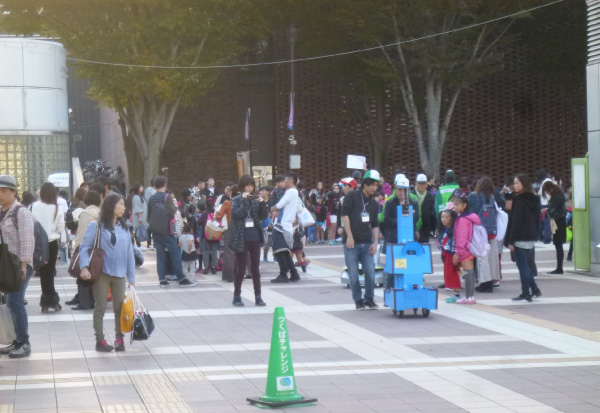Review:
Tsukuba Challenge: Open Experiments for Autonomous Navigation of Mobile Robots in the City – Activities and Results of the First and Second Stages –
Shin’ichi Yuta*,**
*Shibaura Institute of Technology
3-7-5 Toyosu, Koto-ku, Tokyo 135-8548, Japan
**Tsukuba Challenge Steering Committee
1-1-1 Kenkyu Gakuen, Tsukuba, Ibaraki 305-8555, Japan
The Tsukuba Challenge is an open experiment for autonomous mobile robotics researchers who want to build small mobile robots capable of autonomously moving through real and populated pedestrian environments. The Tsukuba Challenge started in 2007 and has been run every year since then. Each year, the self-contained mobile robots of participated team are tasked with autonomously navigating more than 1 km of a given pedestrian pathway through the city. As of 2017, the final year of the second stage, a total of over 500 teams have taken a part in this challenge, by trying to develop their own robot hardware and software to complete the given task. In this paper, the basic concept and the history of Tsukuba Challenge are first explained, and then what has and has not achieved is discussed.

Test run in Tsukuba Challenge in an environment full of pedestrians
- [1] S. Yuta, “Open Experiment of Autonomous Navigation of Mobile Robots in the City: Tsukuba Challenge 2014 and the Results,” J. of Robotics and Mechatronics, Vol.27, No.4, pp. 318-326, 2015.
- [2] Tsukuba Challenge Symposium 2007-2017, January 2007-2017. (It provides opportunities for the participating teams to present their technologies and experiences. In addition, the reports made by all the teams have been issued as proceedings of the symposium in each year.)
- [3] Organized Sessions on the Tsukuba Challenge, The 8th-18th SICE System Integration Division Annual Conf. (SI2007-SI2017), 2007-2017.
- [4] “Special Issue on Tsukuba Challenge, the Autonomous Mobile Robots Challenges to Navigate in Public Road,” J. of the Society of Instrument and Control Engineers, Vol.49, No.9, 2010.
- [5] “Special Issue of The Technical Papers on Tsukuba Challenge – Open Experiments of Mobile Robots’ 1 km Autonomous Navigation in Tsukuba City,” J. of the Robotics Society of Japan, Vol.30, No.3, 2012.
- [6] Y. Takita et al. (Eds.), “Special Issue on Real World Robot Challenge in Tsukuba – Technology for the Coexistence with Human Beings –,” J. of Robotics and Mechatronics, Vol.26, No.2, 2014.
- [7] Y. Takita et al. (Eds.), “Special Issue on Real World Robot Challenge in Tsukuba – Autonomous Technology for Useful Mobile Robot –,” J. of Robotics and Mechatronics, Vol.27, No.4, 2015.
- [8] Y. Takita et al. (Eds.), “Special Issue on Real World Robot Challenge in Tsukuba – Autonomous Technology for Coexistence with Human Beings –,” J. of Robotics and Mechatronics, Vol.28, No.4, 2016.
- [9] Y. Takita et al. (Eds.), “Special Issue on Real World Robot Challenge in Tsukuba – Autonomous Technology for Coexistence with Human Beings –,” J. of Robotics and Mechatronics, Vol.29, No.4, 2017.
- [10] N. Akai, Y. Kakigi, S. Yoneyama, and K. Ozaki, “Development of Autonomous Mobile Robot that Can Navigate in Rainy Situations,” J. of Robotics and Mechatronics, Vol.28, No.4, pp. 441-450, 2016.
- [11] Y. Fujino, K. Kiuchi, S. Shimizu, T. Yokota, and Y. Kuroda, “Integrated Autonomous Navigation System and Automatic Large Scale Three Dimensional Map Construction,” J. of Robotics and Mechatronics, Vol.27, No.4, pp. 401-409, 2015.
- [12] K. Okawa, “Three Tiered Self-Localization of Two Position Estimation Using Three Dimensional Environment Map and Gyro-Odometry,” J. of Robotics and Mechatronics, Vol.26, No.2, pp. 196-203, 2014.
- [13] S. Ohkawa, Y. Takita, H. Date, and K. Kobayashi, “Development of Autonomous Mobile Robot Using Articulated Steering Vehicle and Lateral Guiding Method,” J. of Robotics and Mechatronics, Vol.27, No.4, pp. 337-345, 2015.
- [14] H. Darweesh, E. Takeuchi, K. Takeda, Y. Ninomiya, A. Sujiwo, L. Y. Morales, N. Akai, T. Tomizawa, and S. Kato, “Open Source Integrated Planner for Autonomous Navigation in Highly Dynamic Environments,” J. of Robotics and Mechatronics, Vol.29, No.4, pp. 668-684, 2017.
- [15] R. Mitsudome, H. Date, A. Suzuki, T. Tsubouchi, and A. Ohya, “Autonomous Mobile Robot Searching for Persons with Specific Clothing on Urban Walkway,” J. of Robotics and Mechatronics, Vol.29, No.4, pp. 649-659, 2017.
- [16] T. Tomizawa and R. Moriai, “Using Difference Images to Detect Pedestrian Signal Changes,” J. of Robotics and Mechatronics, Vol.29, No.4, pp. 706-711, 2017.
 This article is published under a Creative Commons Attribution-NoDerivatives 4.0 Internationa License.
This article is published under a Creative Commons Attribution-NoDerivatives 4.0 Internationa License.